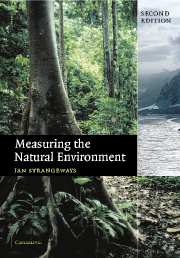Book contents
- Frontmatter
- Contents
- Acknowledgements
- 1 Basics
- 2 Radiation
- 3 Temperature
- 4 Humidity
- 5 Wind
- 6 Barometric pressure
- 7 Evaporation
- 8 Precipitation
- 9 Soil moisture and groundwater
- 10 Rivers and lakes
- 11 Data logging
- 12 Telemetry
- 13 Visibility
- 14 Clouds
- 15 Lightning
- 16 The upper atmosphere
- 17 The oceans
- 18 Cold regions
- 19 Remote sensing
- 20 Atmospheric composition
- 21 Forward look
- Appendix: abbreviations and acronyms
- Index
- References
5 - Wind
Published online by Cambridge University Press: 05 July 2014
- Frontmatter
- Contents
- Acknowledgements
- 1 Basics
- 2 Radiation
- 3 Temperature
- 4 Humidity
- 5 Wind
- 6 Barometric pressure
- 7 Evaporation
- 8 Precipitation
- 9 Soil moisture and groundwater
- 10 Rivers and lakes
- 11 Data logging
- 12 Telemetry
- 13 Visibility
- 14 Clouds
- 15 Lightning
- 16 The upper atmosphere
- 17 The oceans
- 18 Cold regions
- 19 Remote sensing
- 20 Atmospheric composition
- 21 Forward look
- Appendix: abbreviations and acronyms
- Index
- References
Summary
It was something formidable and swift, like the sudden smashing of a vial of wrath. It seemed to explode all round the ship with an overpowering concussion and a rush of great waters, as if an immense dam had been blown up to windward. In an instant the men lost touch of each other. This is the disintegrating power of a great wind: it isolates one from one's kind. An earthquake, a landslip, an avalanche, overtakes a man incidentally, as it were — without passion. A furious gale attacks him like a personal enemy, tries to grasp his limbs, fastens upon his mind, seeks to rout his very spirit out of him.
Joseph Conrad Typhoon.Working on the Cairngorm mountains in Northern Scotland we often experienced gale-force winds while installing experimental equipment (Fig. 5.1). In such places the power of natural forces strikes home. In the winter, on the mountain, there can be a feeling of considerable threat, which I have felt nowhere else. It is not just in a tropical hurricane that the wind's power can be felt.
The variable
Wind is caused by imbalances in the atmosphere due to temperature and pressure differences. The movement of the air is an attempt to attain equilibrium but, owing to solar heating, this is never achieved. Although air movement is three dimensional, the horizontal component is usually by far the greater and this is what is normally meant by the term ‘wind’. However, vertical motion also occurs, both at a small scale near to the ground as eddies caused by turbulent flow and convection, and on a large scale as a result of solar heating in the tropics, which powers the general circulation of the atmosphere.
- Type
- Chapter
- Information
- Measuring the Natural Environment , pp. 69 - 90Publisher: Cambridge University PressPrint publication year: 2003



